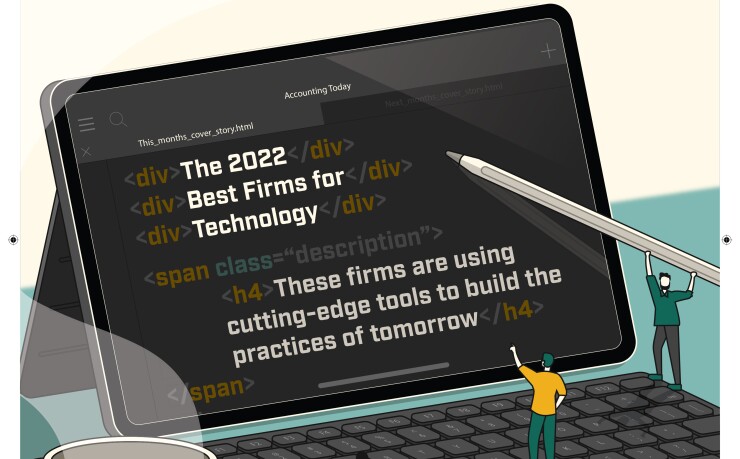Keeping up with technology is a major concern for accountants these days, and the rapid pace of change and the constant flood of new solutions make it even harder for firms to decide exactly where to focus their time, energy and resources.
For this year’s cohort of Accounting Today’s Best Firms for Technology, that means walking a fine line between techno-enthusiasm and techno-skepticism.
At Chattanooga, Tennessee-based Market Street Partners, for instance, “Our first choice for solving problems is through technology and automation,” according to director of operations Jessie Blankenship. “We will only implement a manual workflow if it’s completely necessary, and even then we will constantly reevaluate and be on the lookout for a more automatic solution.”
At the same time, though, the firm carefully prioritizes its tech investments to make sure they bring intuitive and automatic workflow for staff, and improve its quality of service, all while keeping an eye out for new developments. “We are regularly updating our tech stack as new products and upgrades hit the market,” Blankenship explained.
Greg O’Brien, CEO of Boston-based GO CPA, was even more explicit about carefully vetting potential solutions. “We avoid ‘Shiny Object Syndrome’ at all costs,” he said. “We first see what the functionality is and if it competes with an existing piece of tech we have. … The ‘return on hassle’ factor is something that must be considered. Switching constantly hurts morale and is extremely expensive. Thus, the investment must dramatically increase employee happiness/morale and efficiency versus what the current software or tech we have for that area.”

In East Brunswick, N.J., WilkinGuttenplan has a straightforward set of criteria for judging solutions: “Our strategy is fairly simple. All technology systems need to be secure, available, performant, and connected for our staff, in that priority,” explained principal Tom Hasard. “We want all of our tools to be secure, protecting our client's information and making it easy for our staff to comply with various regulatory requirements. Our systems need to be available for access from as wide a range of platforms and locations as possible to help enable our overall firm strategy of delivering truly flexible work. … Finally, we have pivoted towards a connected ecosystem of applications and tools that allow information to flow between systems.”
At New York-based Berdon, meanwhile, chief operating officer Rebecca Goodman-Stephens said that the Top 100 Firm prioritizes its tech investments by doing a business case value assessment based on:
- Quality of life/employee experience;
- Improved productivity (time saved and leverage model included);
- Impact on client experience (added value to client service and/or added convenience);
- New revenue stream/new potential service/billable service; and,
- Ease of integration (the firm has an integrated data structure to ensure a single point of data entry and seamless flow of information).
Innovation and people
Calculating the value of a tech investment can be even more complicated when you may be creating the technology yourself, as Top 20 Firm Marcum does in its own Marcum Labs, a technology incubator that focuses on developing new products, solutions and services to either improve the delivery and quality of the firm’s work product, or drive increased service value to clients.
“Technology has been and continues to be one of the cornerstones of the organization,” explained principal and chief information and digital officer Peter Scavuzzo. “It has become one of the larger investments in the firm and one embraced by the entire organization.”
Because it’s so important, the firm has a carefully-thought-out review process for new tech possibilities. “Each innovative idea and technology investment is reviewed and placed into three categories,” Scavuzzo said. “The first category is driving efficiency and quality within our practice. The second is whether it can drive added value and differentiate Marcum in the marketplace. And the third is whether we can generate digital revenue from our investment by creating a new solution, service or product. We try to evenly balance our investments across each category. Once we place it in one of the categories, we then go through the process of evaluating the level of effort and cost and then comparing it to the value and impact the investment would have [on] the firm. Based off those results, a project is then prioritized accordingly.”
Top 10 Firm Grant Thornton has its own proprietary and standardized ROI model for assessing tech investments — one that includes an element that many of this year’s Best Firms for Tech like to include in the mix: the firm’s people.
“Working with stakeholders across the firm, from more junior staff to our partners and principals, this model enables us to understand the quantitative and qualitative aspects of each technology request,” explained chief transformation officer Jamie Fowler. “We often find the best ideas and technologies come from our people, many of whom have limited years of experience but see our work for clients firsthand at its most basic level.”





